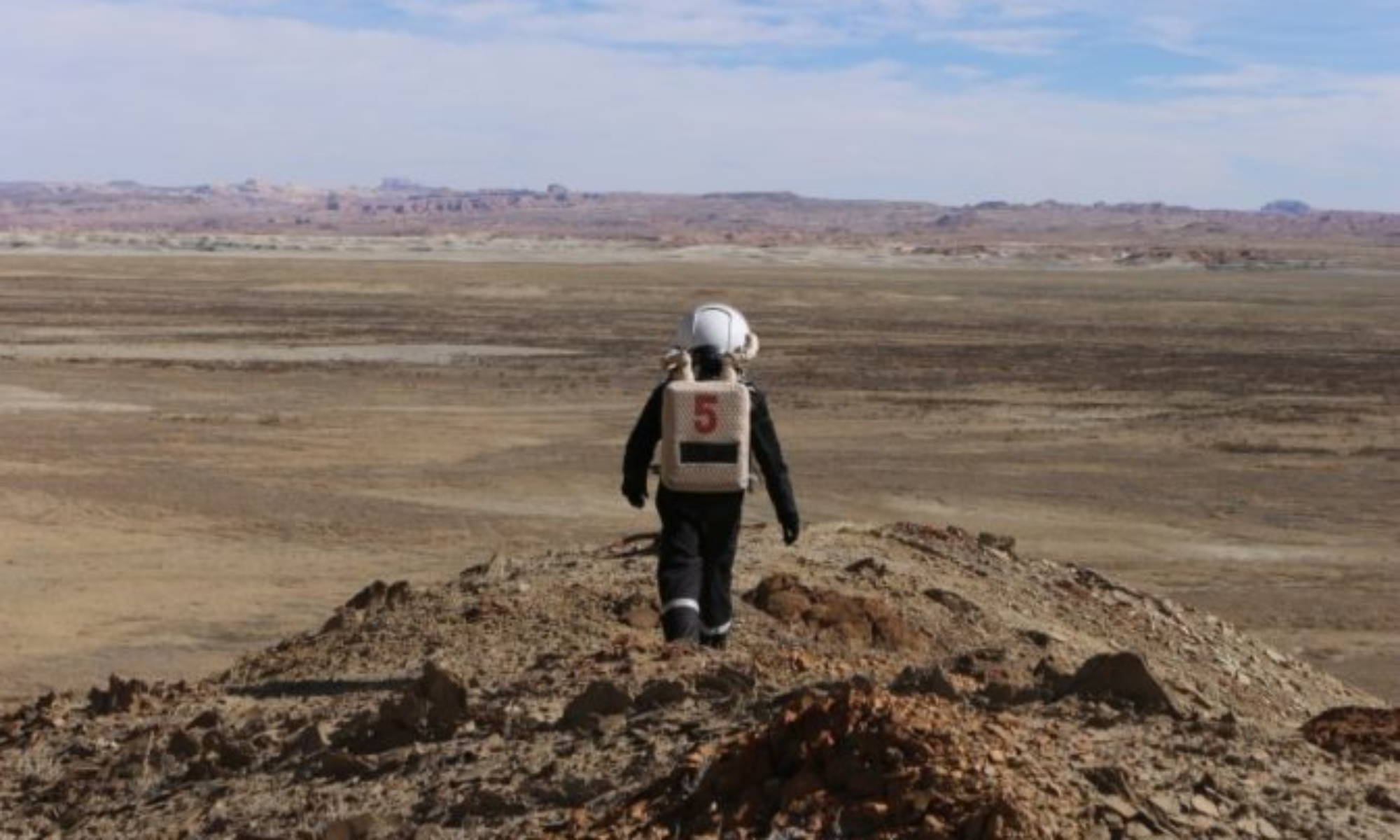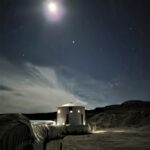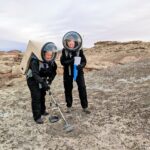[category science-report]
Crew 269 Mid-Mission Research Report
Mid-Mission Research Report
Crew 269 – The Aerospace Corporation Crew
27 Nov – 10 Dec 2022
Commander: Dr. Kristine Ferrone
Executive Officer: Allison Taylor
Health and Safety Officer: Barbara Braun
Green Hab Officer : Matthew Eby
Engineer: Ashley Kowalski
Technology Officer: Trevor Jahn
I. EVA Planning (A. Taylor)
Crew 269 completed on-site training, configured experiments, and prepared equipment prior to simulation start. The crew has been adaptive to EVA planning needs, requirements, site constraints, and other challenges such as windy conditions impacting launch decisions for the drone. The original EVA plan provides a template for mission objectives, and color-coded blocks allow for shifting and replanning daily prior to submitting the EVA requests to MDRS mission support. Our look ahead plan for EVAs includes another mirror payload retrieval, inspection, and redeployment, along with additional photogrammetry with drone, augmented reality demonstrations, tools testing at additional sites of interest, ham radio antenna deployment, and high-altitude weather balloon deployment.
II. Project Phantom Virtual Reality/Augmented Reality Demonstration (T. Jahn)
The primary objectives of this activity are to demonstrate using various photogrammetry techniques to create 3D models from data collection done by flying drones, remote control rovers, and handheld devices; demonstrate using augmented reality (AR) software for mission planning, demonstrate AR software for EVA activities, and demonstrate mission planning for using photogrammetry data. Since arriving at MDRS, I have demonstrated using various photogrammetry techniques to create 3D models from data collection done by flying drones, remote control rovers, and handheld devices. Timelapse photos have been collected multiple times from remote control rovers, and the first drone flight to collect timelapse photos has been completed with more planned for next week. Timelapse photos have been sent to The Aerospace Corporation mission support team, and they have been processing them to produce the best outcome for at least a few days. I also demonstrated using virtual reality hardware software for mission planning; at least one EVA was planned using virtual reality and 3D mapping from satellite imaging. I’ve also demonstrated augmented reality software on multiple EVAs and continue to work in conjunction with Aerospace mission support to improve it for the remainder of the mission. I’ve also demonstrated mission planning using photogrammetry data. Data has been uploaded to the Aerospace mission support team for processing to be used in mission planning during the second week of the mission, and I’ve received the first 3D models from the Aerospace mission support team with more expected early next week.
III. Mirror Coating Experiment (A. Kowalski)
Highly reflective silver mirrors are used in many space applications, but exposure to environmental contaminants can rapidly degrade optical performance. The primary objective of this experiment is to monitor and characterize mirror surface degradation under a simulated, accelerated environmental exposure over the two-week period we are here at MDRS. To fulfill this objective, we deployed four different mirror samples close to Marble Ritual on Sol 1. On Sol 5, I inspected the mirror samples in the Science Dome under the Aerospace Corporation microscope, noted the locations of abnormalities on the mirrors, and saved images of those areas. Upon completion of this inspection, we redeployed the mirror samples to the Martian environment on the same day. I will perform two more mirror sample retrievals, inspections, and redeployments during the remaining time at MDRS.
IV. EVA Tools Demonstration and Regolith Sample Collection (A. Taylor)
The main goal of demonstrating the EVA tools is to evaluate the operational use of the selected commercial-off-the-shelf (COTS) tools in accomplishing regolith sampling during planetary surface EVAs. The tools include a rake and scoop, handheld battery-powered sifter with 75-micron mesh, and special sample collection bags. Since arriving at MDRS, the crew has successfully collected six regolith samples from sites near the Hab, the Special Region in the Valles Marineris quadrant, and other sites of interest along known traverse routes. The tools are performing and holding up well, and photographs for each collection site have been taken. The sifted regolith is the first step in the beneficiation of material for in situ resource utilization (ISRU) processing, as ISRU processing requires specific grain sizes. The regolith samples will be sent to a laboratory at The Aerospace Corporation for analysis to determine if any of the sampled regions near MDRS have compositions suitable for ISRU processing, such as creating building materials. We hypothesize that samples from the Moon and Mars will be analyzed for purposes such as future site construction with the goal to maximize the use of in situ material.
V. Radiation Environment Monitoring and Mapping (K. Ferrone)
The primary objective of this activity is to demonstrate the use of a handheld portable radiation dosimeter to collect GPS-tagged radiation dose rate data to create a dose rate map of a designated area on Mars or other planetary surface. Since arriving at MDRS, I have collected GPS-tagged environmental radiation dose rate measurements at regular intervals using the handheld Radex RD1212-BT radiation dosimeter. This dosimeter records the GPS-tagged dose rate in preset intervals, and that data can be used to create a radiation dose rate map. Crews could use such a map to aid in EVA planning to identify exposed or protected solar radiation areas or to locate radioisotopes on the surface. The GPS-tagged radiation dose rate data may also be integrated into VR/AR models created by Project Phantom in the future.
VI. Weather Balloon Release (M. Eby)
The main goal of the balloon experiment is to prepare and launch a high-altitude weather balloon in an analog Martian environment and space suits. The experiment will measure the dust in the atmosphere from ground level to 90,000 ft, but the use of balloons on Mars enables a range of rapid response, on-demand science and communications payloads. Since arriving at MDRS, I have tested the ground tracking station. Flight batteries will be loaded into the payload within the Hab this weekend, completing our preparation. Weather pending, launch is expected on Sol 11.
VII. Exercise and Fitness Protocols (B. Braun)
The main objective of this activity is to evaluate compact fitness equipment (provided by Hygear) and other exercise protocols for maintaining astronaut fitness in a confined habitat or space station environment. Since arriving at MDRS, 5 of 6 crew members have used the Hygear fitness bands and jump rope equipment. The fitness bands have a simple attachment mechanism consisting of webbing and a carabiner that can be adjusted to fit into several slots; this makes it ideal for use in an environment with limited fixed mounts as it can be attached to any permanent solid structure at many different heights to facilitate exercising different muscle groups. The bands also are very compact and easy to transport, and use elasticity rather than weight to provide resistance, which is appropriate for a low-gravity environment. However, the bands do require a moderate amount of space to stretch to their full length, which might be difficult to find in a station or habitat environment. Crews are finding the jump rope and rope-free weighted jump balls surprisingly effective; the weighted rope-free handles are particularly effective for confined spaces. The 15-minute workouts are quick and can be done in and around other duties, but the crew is having difficulty fitting the recommended three workouts into their day, especially given the overhead required to change, set up for a workout, and then stow gear and change back into station gear after the workout is over. Crew members are also utilizing exercise videos which allow for a nearly infinite variety in workout types and styles, but which would be less effective in a low-gravity environment. The crew will continue to evaluate the fitness protocols throughout the end of the rotation
VIII. Discord Crew Communication Demonstration (B. Braun)
The purpose of this activity is to demonstrate low-bandwidth high-latency messaging (similar to texting) as a way for crew members to keep in touch with family and mission support back “home.” The protocol is set up through a special Discord server which is limited to invited members only. The server simulates the light-time delay between Earth and Mars (currently five minutes each way) and allows only text-based messaging (no voice or video). Each crew member has private channels for talking to family and friends, and group channels for talking to principal investigators, mission support, and STEM teachers back on “earth.” The crew has used the Discord server extensively, not only to communicate with family and friends, but also answer questions from elementary school classrooms and to discuss experiment protocols with principal investigators. In one case, a crewmember used the Discord server to consult with a subject-matter expert back on earth about an anomaly in an experiment setup. The crew plans to continue to evaluate the use of Discord over the rest of the rotation to determine how effective low-bandwidth communication is at keeping crew members in touch.
IX. Ham Radio Demonstration (K. Ferrone)
The objective of this activity is to demonstrate that crews can successfully deploy a ham radio field antenna in a Mars analog environment and space suit to aid in surface navigation and communications. Since arriving at MDRS, the three ham radio operators on the crew (Ferrone, Braun, Eby) have completed activation and checkout of the MDRS ham radio station and two of our own handheld ham radios and trained on the deployment procedure for the antenna. EVA is planned for Sol 7 to deploy antenna and initiate contacts.
X. Green Hab Operations (M. Eby)
The primary objective of this activity is to gain experience in the day-to-day operations of growing and caring for plants in a simulated Mars station. Since arriving at MDRS, I have worked with plants at various stages of the growth cycle from new seedlings, to plants starting to flower, to plants ready to harvest. Edible plants supplementing the crew dinner table are tracked based on weight and date harvested.










You must be logged in to post a comment.